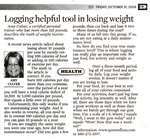 Logging helpful tool in losing weight Logging helpful tool in losing weight
A recent news article talked about losing about 10 pounds per year by merely cutting 100 calories of food or adding in 100 calories of exercise per day.
The math in the article is correct. If you burn 100 calories per day more than you consume, over the period of a year you will have a total calorie deficit of 36,500. At 3500 calories per pound, that equals a little over 10 pounds. Unfortunately, this only works if you are currently maintaining your weight. And it also works in reverse, all you need to do is overeat 100 calories per day and you can gain 10 pounds in a year.
If you are roughly the same weight you were one year ago, how did that maintenance occur? Did you gain a few pounds, then cut back and lose it two or three times during the year? Many of us fall into this group. If so, you are not eating at a daily maintenance level.
So, how do you find your true maintenance level? This is where logging can really play an important role. Not just food, but activity and weight as well.
Over a three month period, log all of your food and activity daily. Log your weight weekly. It doesn't matter if you are currently trying to lose or not. For your food, do your best to estimate all of your calories consumed.
For your activities, don't just log time and activity, log intensity as well. After all, there are those days when we have a great workout as well as those days when we barely get through our gym time. Use a scale of 1-5, where 1 equals "Well, I went to the gym today" and 5 equals "Wow! Now that was a workout!"
Watch how your weight reacts to your food and activity levels. If it is staying level, you can cut those 100 calories and you'll lose around 10 lbs in a year. If you are slowly gaining, look at your food and see what you need to cut to either maintain or lose. If you are losing, great! Eventually you will be able to add a few calories back in and still maintain your weight.
Keep in mind that metabolisms change. If you notice weight creeping back on, go back to your logging and figure out what changes you need to make.
Also, regarding my last article on salads, Suzie from Tempe sent this tip: "I've always enjoyed a warm chicken salad in restaurants so I decided to try them at home… I get grilled chicken strips, warm them in a little PAM and put them on top of a huge green salad with tons of veggies. We are always full."
Thanks for the tip Suzie! |

